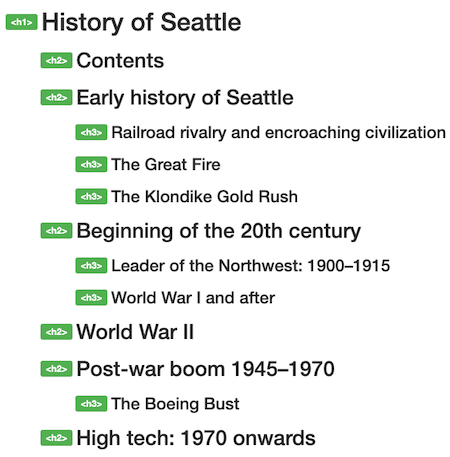ABOVE IMAGE: Writing doesn’t have to be painful or bad for your tooth enamel.
Write an F’n Blog Post Pt. #1 Topic Selection and Outline Creation
Breathe. Just Breathe.
You know it’s high time that you produce some content for your website’s blog. Congratulations on making the commitment to publish something … (gasp) … YOU’ve written!
You’re not going to sacrifice a piece of your soul; the world will go on turning (unless you write something completely earth-shattering).
How to Write an F’n Blog Post
What I aim to provide in this series is a sensible guide to writing content for your blog without racking your brain any harder than necessary.
In part 1 of this series, we’ll focus only on the first two steps of my entire writing process:
- Pt. #1: Select an Actionable Topic and identify its purpose
- Pt. #1: Outline your topic as a short sequence of steps
- Pt. #2: Record your initial explanation of the topic’s Outline in one take
- Pt. #2: Edit: Rework the transcript into your Outline’s steps
- Pt. #2: Publish that sucker
- Pt. #3: Bonus: Embellish your writing with media, styling, and additional resources
- Pt. #3: Bonus: Optimize anything else you can think of
Drop your perfectionist tendencies! In this post, we’re gonna whip up a choice Topic and Outline without overthinking it.
1) Select an Actionable Topic relatable to you and your blog
Topic selection is the most crucial aspect of writing a blog post. If you don’t know what you’re writing about and what purpose it serves, the entire writing process becomes very slow and misguided.
So, how to you select a content topic and determine what purpose it serves?

ABOVE IMAGE: Readers will leap from article to article until they’ve found just the post they need. Will your Actionable Topic meet their needs?
Introducing the Actionable Topic Concept
Before going any further into my process for writing website content, it’s important to understand the basic elements of a “good topic”. So what is that?
First, when planning a new post to write for your website, you should already have a few bases of the post’s topic covered. Such as:
- Is this post’s topic related to what your website is about, overall?
- Is it going to be distinct from existing content so it stands out?
- Would your audience actually want to read this content?
Next, you must understand precisely what the greater subject of your topic is so that you can discuss a specific purpose within the larger framework.

ABOVE IMAGE: A true topic consists of a subject and an inherent purpose for the reader.
Actionable Topics Accomplish one or more Goals
Actionable blog posts create this impression in the reader:
“Oh, I’m going to read this post because it does something for me.” — Your Reader
An Actionable Topic should do at least one of these things:
- Provide quality information
- Show how to do something, or
- Entertain or is share-worthy
Your topic certainly concerns a subject of some nature, but what is it ABOUT this subject that your post will portray for the reader?
Write your Actionable Topic as your Post’s Headline
In just one, single sentence. Your headline should:
- Include the subject of your topic and
- Declare its goal, directly or indirectly.
Write it from the perspective of your reader, who is looking for the information, instructions, or entertainment. They have a need — Your post holds the solution.
You can spend a little bit of time writing out this headline, but don’t sweat it too much. Your Actionable Topic is a guide along the writing journey and you can change it up as you go.
Do you have your own Actionable Topic now??? Capture it as a single sentence and write it down.
Topic Example: A Pizza Guy’s Actionable Topic Headline
Imagine me as a pizza parlor owner who wants to create a new blog post about pizza crusts, because people always ask about our crusts.
MY SUBJECT = Pizza Crusts
ACTION = Learn the characteristics of different types of pizza crusts.
Which real Headline matches the pizza guy’s Actionable Topic?
- Buy Pizza Crusts on Amazon | Low Prices for Pizza Crusts
- 6 Pizza Crust Alternatives That Are As Healthy As They Are …
- 10 Different Pizza Crust Varieties: Which is Best for You?
- Ultimate Pizza Dough Recipe – Crazy for Crust
10 Different Pizza Crust … of course!
The pizza guy decides that his Actionable Topic or is “Pizza crust varieties every pizza lover should know.” That basically equates to his post headline as well.

Regardless of what my target reader actually types into a Google Search, what they’re thinking is: “I want to know what kinds of pizza crusts there are.”
And you ALWAYS write topics for the readers’ needs.
HINT: Keep an ongoing idea bank to capture and store ideas for your blog so that you don’t have to start this process from scratch each time you want to write.
BONUS: Expand your actionable topic further by writing it as a few pieces of webpage metadata that feed Google and other Search Engines (URL slug, title tag, meta description). I have a metadata writing template you are free to copy from Google Docs and use.
2) Create the simplest Outline possible to contain the entire post topic or idea
Now, think about the deeper structure of your Actionable Topic.

ABOVE IMAGE: This is where we start putting all of the pieces together to form the DNA of an organic blog post.
Guides and Descriptions | Two Outline models
Does your topic demonstrate some activity (like a recipe or how-to)? Maybe it describes something (product reviews, news, research)?
Activities and other types of how-to guides have a structure that follows a predictable linear order:
- You want something
- So do this
- And do that (continue as needed)
- And then it works!
Descriptive topics seem less than… actionable. However, they rely on detail in more than just one dimension to satisfy the scope you’ve given them.
You wouldn’t write a page about “Seattle’s History” and only mention the early 1990’s. You’re gonna write a TON to adequately address a topic so vast.

ABOVE IMAGE: Here we see how Wikipedia’s table of contents “Outline” breaks out its page’s topic “History of Seattle”
Descriptive Outlines mention different aspects or qualities of their subject. Still, prioritize the order in which these characteristics are to be presented by using some reason. Histories are chronological, pizza crust types might be sorted by popularity.

ABOVE IMAGE: Pizza crusts as a topic is much more manageable to cover in a single piece of content. The logical structure seen here in the page’s headings represents something close to the Outline we’re creating here.
Go ahead and write your Outline
Your Outline will consist of about 3-10 points that either tells the reader:
- How to get from point A to point B, or
- There are X, Y, and Z qualities of this topic to mention
The title of each section is simply a short sentence or a term that explains one step in a process or one section of the topic you want to cover.
Read aloud your Outline’s steps in order
Reading from top to bottom should essentially tell your reader the gist of what your post in presenting.
As you’re writing your Outline’s steps, read them all together in order as if they were the only content your post contained. The Outline should stand on its own, though it will become much more value with more detail.
Outline Example: A pizza guy’s Outline for his pizza crust post
Actionable Topic = Pizza crust varieties every pizza lover should know
Now let’s simply expand the Outline’s points into fuller statements (sorted in no real order other than my preference):
- These are your typical pizza chain crusts in America
- Crusts you’ll find in high-quality American pizzerias
- Traditional Italian pizza crusts by region of origin
- Some crazy International and Exotic crust varieties
- Ingredients in Gluten-Free and alternative pizza crusts
In reading my Outline through from beginning to end, I get a feel for the overall flow of my pizza crust blog post. I change things around until I feel that the order of my points makes sense for my purposes.

Now let’s see what you’ve got for your new post!
With your finished step-by-step Outline and Actionable Topic, you’re ready to move on to the meat of this post writing business.
Hang tight for part 2 of this series. In the meantime, get some practice in writing Actionable Topics and Outlines for your future blog posts.
TIP: Consider the scope of your Outline before going on:
- Is it too simple?
- Too Complex?
- Could you realistically explain the above-mentioned steps with enough detail for someone to follow you?
If it would take too long to guide readers through your Outline from beginning to end, you may need to stop, break up this post into a multi-post series, or select one step of the Outline to break out as its own post.
NOTE: The steps in your Outline will effectively serve as your post’s subheadings once published. These subheadings will start to gain substance later on.
Your readers should crave the juicy material between each step in your Outline, which we’ll cultivate next.
By, Colton James Townsend (read more like this on my website)

- 2020 Director of Promotions for Seattle Search Network
- Co-Founder of Tall Town design, Incorporated (Digital Marketing in Des Moines, WA), retired
- Copywriter and Website Publisher at Colton James Townsend, LLC

